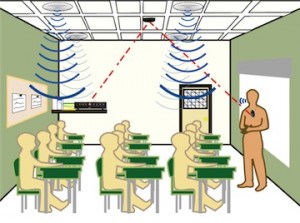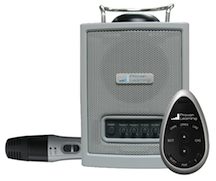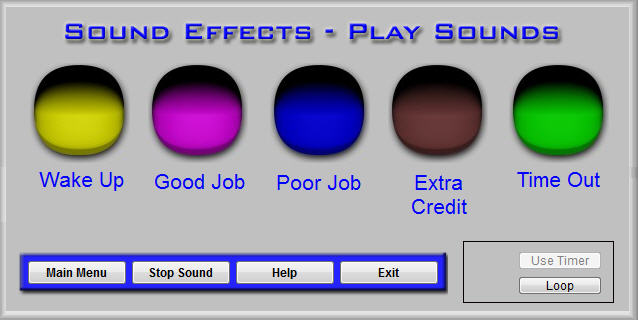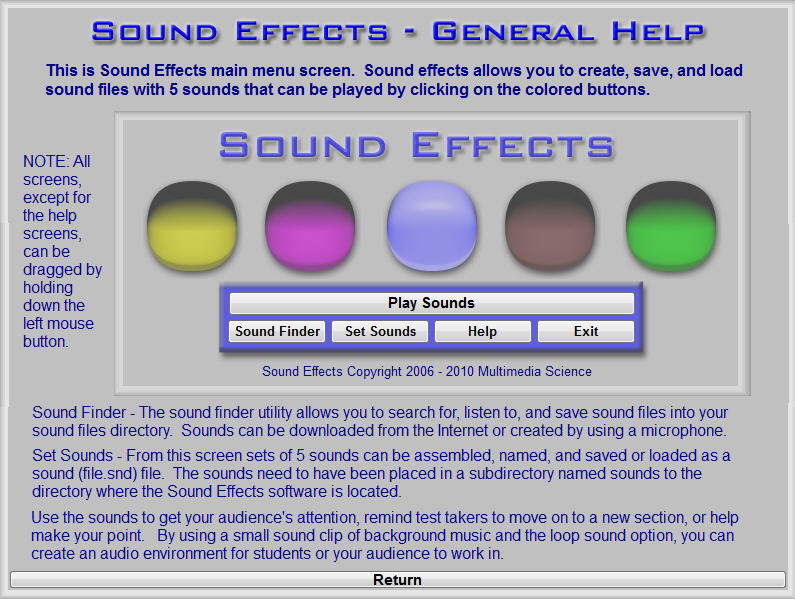Sound Effects
Sound affects our life, often without our knowing it. A person talking while you are trying to read or write reduces your productivity by over 60%. Offices with open floor plans allow conversation noise that is highly distracting, reduces performance, increases stress hormone levels, and causes less interest in relating with others. Classroom Effects on Students Classrooms are perfect examples of offices with open floor plans. They are often noisy and distracting due to: – talking, desk tapping, sneezing, sighing, and coughing – hall traffic, school announcements, noise from adjoining classrooms – open windows, airplanes, busy roads – fans, humming lights, cooling fans from computers, projectors, etc. – shuffling papers, tile floors, ticking clocks, phone calls The World Health Organization recommends a noise level in classrooms of 35 decibels, about what you would expect in a library. Often, however, the average noise volume is closer to 65 decibels. Julian Treasure states, speech intelligibility is just 50% for a student sitting in the fourth row of a traditional classroom. A link to one of his TED talks is given below. These acoustic deficits are even worse for K-5 students who had high levels of mild hearing loss due to common ear infections.
Julian Treasure: Why architects need to use their ears
The United States General Accounting Office found that roughly 28% of all schools reported unsatisfactory or very unsatisfactory acoustics or noise control. The bottom line is that our noisy classrooms are having significant effects on the ability of our students to learn.
Classroom Effects on Teachers
When a person is placed in a noisy environment, they tend to talk louder. This means that teachers have to raise their voices to try and be heard in the back of the room, straining their voices. This involuntary reflex is known as the Lombard effect, causing changes to loudness, pitch, rate, and duration of speech sounds. A study published in the Journal of Speech, Language, and Hearing Research concluded that teachers were significantly more likely to experience hoarseness, discomfort, and increase effort when speaking. This constant straining can lead to damage to their voices over time and frequent bouts of laryngitis.
So, classroom noise pollution has a negative effect on both teachers and students. In my classroom experience of over 30 years, I seldom made it through a year without at least one bout of laryngitis. Often this would start with a minor common cold, but come on after a number of days of talking. I always has the theory that I could teach and take it easy on my voice by not talking. But in practice, students tended to take advantage and talk more when I was not able to raise my voice. Is The Solution In Improved Room Acoustics?
Most classrooms are constructed of square cinder block arrangements including hard surfaces like blackboards and windows. Sound tends to bounce off of these surfaces and lead to excess reverberations, often called the echo effect. There are a number of classroom additions that can help improve the room acoustics such as: – Carpeting on classroom floors – Rubber chair leg tips reduce chair movement noise – Echoes can be eliminated using sound absorbing materials or strategically located bookshelves and furniture – Entry doors that are fully sealed – Acoustical ceiling tile with sound absorptive surface – Lower ceiling heights, preferably less than 10 ft
Unfortunately, the cost effective way to construct noise abatement into classroom design is during the initial construction. After the classrooms are constructed, changes are much more difficult and expensive.
During my teaching tenure, I was lucky enough to work at a well-funded and well-run school district. But even there, the sound environment left much to be desired. The windows were not double paned, leaked air, and needed to be open during the summer due to a lack of air conditioning. The blowers in the classroom were noisy, the ballasts in the fluorescent lights often buzzed, and the water running through the pipes could be heard in the ceiling.
And assuming that the money could be found for the major reconstruction necessary to significantly improve the sound quality in classrooms, the existing infrastructure precluded this being either easy or cost effective.
How About Using Sound Amplification Systems?
Many online articles and sound amplification vendors tout the use of an amplified sound system to solve classroom sound quality problems. The Marrs Project (Mainstream amplification Resource Room Study) is often cited showing that the use of an amplified microphone system significantly improved the learning environment and led to improved student improvement. Some of the quoted benefits are: – Improved attention and On-Task time – Increased class interaction and participation – Reduced classroom stress and less behavior problems – Less teacher days lost to voice and throat illness – Improved academic test scores
Other online articles claim that microphones and loudspeakers in the classroom are a misguided attempt to solve acoustical problems. This has been the position of the Acoustical Society of America to NOT routinely employ sound amplification in typical small classrooms. Some of the problems cited are: – Amplification systems create an additional complication for the teacher – These systems will not solve reverberation or echo problems – These systems increase overall sound levels in the classroom – Amplified sound may be heard in the hallways or in other classrooms
Solution to the Conundrum (or eardrum)
After more digging, it seems that here are several different types of amplified classroom equipment. Teachers were almost always positive about the use of and student response to use of an amplified system. Over time, however, they found that students’ performance was not better than in a non-amplified classroom. This could be because of the so called Hawthorne effect, where any change increased productivity in the short term.
One of the amplification systems is called SFS, or sound field systems. SFS requires speakers installed in the ceiling and a wireless microphone used by the teacher. A signal from the microphone is transmitted to a receiver which amplifies and directs the sound to the speakers. The wireless signal bounces around the room, assuring the teacher can be heard anywhere in the room. Makers of the SFS technology claim that their technology provides the benefits of sound amplified systems noted above and keep on providing these benefits over time.

Figure 1: Proven Learning Website
The oft cited MARRS study was completed in the 1980s. More research is needed to determine what the magnitude of the classroom sound deficiencies are and how well new technology works to provide a solution.
My experience with “amplified sound systems” has been quite positive. After picking up an old Karaoke machine at a thrift store and buying a cheap microphone, I brought the equipment into my classroom. Initially I only used it to play soothing music while students were solving problems during class time. Then I got a case of laryngitis. I replaced the wired microphone with a wireless one and what a difference. I was able to teach instead of giving my students hand signals. And by taking the strain off of my voice, I feel that I recovered more quickly. I never used the system on a regular basis, so I can’t add much to the discussion of whether the value of the amplified system diminishes over time.

The most fun event using the amplification system was right after I got the wireless microphone. I found that the amplifier would pick up the signal even when I was in the back room where students could not see me. One day I waited until all of the students were seated and started to give them directions invisibly from the back room. We all got a good laugh out of it.
Sound Effects Software
The Sound Effects software allows you to create, save, and load sound files that include five sounds that can be played by clicking on colored buttons from the Play Sounds screen. Sound Effects includes several screens and tools that make it easy to create sets of sounds that you can save and load at any time. There are many, many uses for Sound Effects. Use the sounds to get your students’ attention, indicate whether question answers are correct or incorrect, remind test takers to move on to a new section, play recorded directions, or help make your point. By using a small sound clip of background music and the loop sound option, you can create an audio environment for students to work in. Several screen shots are shown below. The Sound Effects Software is available from the following link.
One of the reasons that I created the Sound Effects software was to help save my voice when I was sick or had laryngitis. I could record the instructions for my first class and play them back to the following classes. I could also use the Wake Up, Gong, and other sounds to get students attention or stop them from talking.
Another great use for the Sound Effects software is in preparing for a substitute teacher. You probably know that students don’t always pay much attention to a substitute and it is hard to lay out instructions clearly and quickly. Use Sound Effects. Record five clips of directions, suggestions, warnings, etc. and have them set up for the substitute to run. I’ve tried it and it is a great improvement over written substitute plans.

Figure 2: Sound Effects Play Sounds Screen

Figure 3: Sound Effects Software Help Screen
